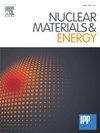Fluctuation entrainment and SOL width broadening in small/grassy ELM regime
IF 2.3
2区 物理与天体物理
Q1 NUCLEAR SCIENCE & TECHNOLOGY
引用次数: 0
Abstract
This study delves into the phenomena of fluctuation within the Scrape-Off Layer (SOL) of tokamak fusion reactors, with a specific focus on its impact on SOL width, particularly during grassy Edge Localized Modes (ELMs). Employing a comprehensive approach involving analysis and simulations, including BOUT++ and UEDGE simulations, we examine the role played by the fluctuation energy flux () and various control parameters in shaping the dynamics of fluctuation entrainment. Our findings shed light on the intricate process of transporting fluctuation energy from the pedestal to the SOL, a process influenced by critical factors such as fluctuation correlation length and SOL electric field shear. These insights yield valuable strategies for effectively managing SOL width and achieving plasma detachment, both of which are essential for optimizing fusion reactor performance and ensuring operational stability. Notably, the adoption of H-mode with small/grassy ELMs holds significant promise in addressing three pivotal challenges for future tokamak fusion reactors: minimizing the size of ELMs, expanding the SOL width, and aiding in the detachment of divertor plasma at lower plasma densities, all while avoiding back transitions to low confinement and disruptions.
求助全文
约1分钟内获得全文
求助全文
来源期刊

Nuclear Materials and Energy
Materials Science-Materials Science (miscellaneous)
CiteScore
3.70
自引率
15.40%
发文量
175
审稿时长
20 weeks
期刊介绍:
The open-access journal Nuclear Materials and Energy is devoted to the growing field of research for material application in the production of nuclear energy. Nuclear Materials and Energy publishes original research articles of up to 6 pages in length.
 求助内容:
求助内容: 应助结果提醒方式:
应助结果提醒方式:


